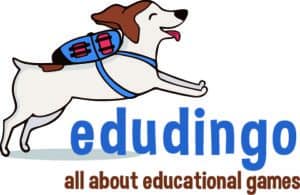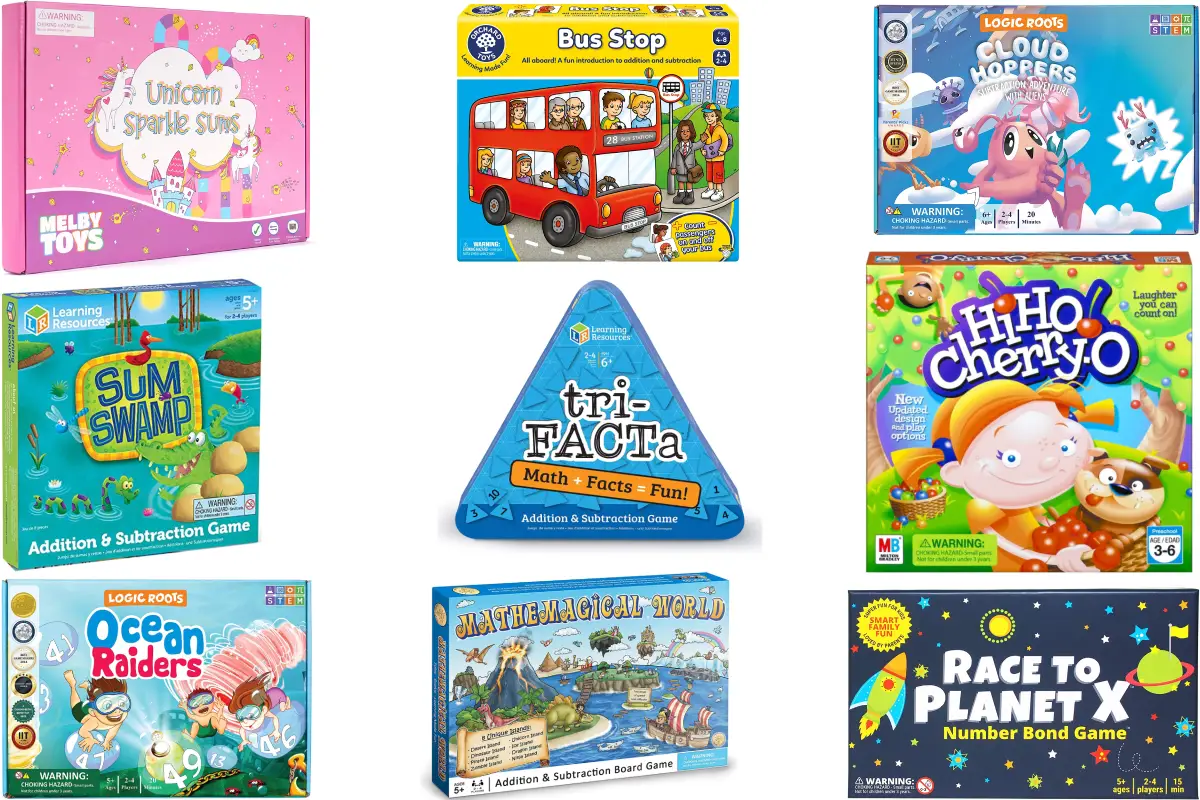This post contains affiliate links.
Children are expected to master addition facts in first grade and subtraction facts during second grade. However, if you want to start as early as prekindergarten, do not worry.
I found 13 multi-player board games that are dedicated to practicing:
- Addition like Ocean Raiders
- Addition and Subtraction, such as Cloud Hoppers
Addition and Subtraction Board Games Comparison Table
This table offers a quick reference on the features of each board game. Most board games are ideal for playing at home and school.
| Game | Focus | Age | Players | For | Price | Rating |
| Ocean Raiders | Addition | 5+ | 2-4 | Families, Teachers | $$ | ★★★★☆ |
| Pop and Add to 20 Game | Addition | 4-6 | 1-2 | Teachers | $$$ | ★★★★☆ |
| Simple Addition Magnetic Activity Tin | Addition | 4-6 | 1-3 | Teachers | $$$ | ★★★☆☆ |
| Addition Flip and Solve Board | Addition | 3-6 | 1-2 | Families, Teachers | $$$ | ★★★☆☆ |
| Sum Swamp | Addition and Subtraction | 5+ | 2-4 | Families, Teachers | $$ | ★★★★☆ |
| Pop to Win! Math Game Gr. 2 | Addition and Subtraction | 7 | 2-4 | Teachers | $$$ | ★★★★☆ |
| Cloud Hoppers | Addition and Subtraction | 6+ | 2-4 | Families, Teachers | $$ | ★★★★☆ |
| Mathemagical World | Addition and Subtraction | 5+ | 2-4 | Families, Teachers | $$$ | ★★★★☆ |
| Bus Stop | Addition and Subtraction | 4-7 | 2-4 | Families, Teachers | $$ | ★★★☆☆ |
| Race to Planet X | Addition and Subtraction | 6-8 | 2-4 | Teachers | $$ | ★★★☆☆ |
| Hi Ho! Cherry-O | Addition and Subtraction | 7-8 | 2-4 | Families, Teachers | $$ | ★★★☆☆ |
| Tri-Facta | Addition and Subtraction | 6-8 | 2-4 | Teachers | $$$ | ★★★☆☆ |
| Unicorn Sparkle Sums | Addition and Subtraction | 4-8 | 1-4 | Families, Teachers | $$ | ★★★☆☆ |
4 Addition Board Games for PreK to Grade 1
Ocean Raiders (Logic Roots)

★★★★☆
For Parents and Teachers | Age 5+ | 2-4 Players
Ocean Raiders is a Snakes and Ladders-inspired game with a twist. The numbers on the board are non-chronological, and you must add the number on the dice to your current position on the board to move.
is a Snakes and Ladders-inspired game with a twist. The numbers on the board are non-chronological, and you must add the number on the dice to your current position on the board to move.
This board game is exciting, unpredictable, and relevant for 5–7-year-olds because they will learn:
- Number sequencing
- Counting
- Addition of single and double-digit numbers
- Addition with 0
I like that:
- Children will learn to add large numbers
- It features two gameplay modes: easy and advanced.
- This game can be used to teach subtraction.
Most importantly, I recommend Ocean Raiders because young and old kids with different math skills can enjoy the game and play together.
because young and old kids with different math skills can enjoy the game and play together.
Pop and Add to 20 Game (Lakeshore Learning)
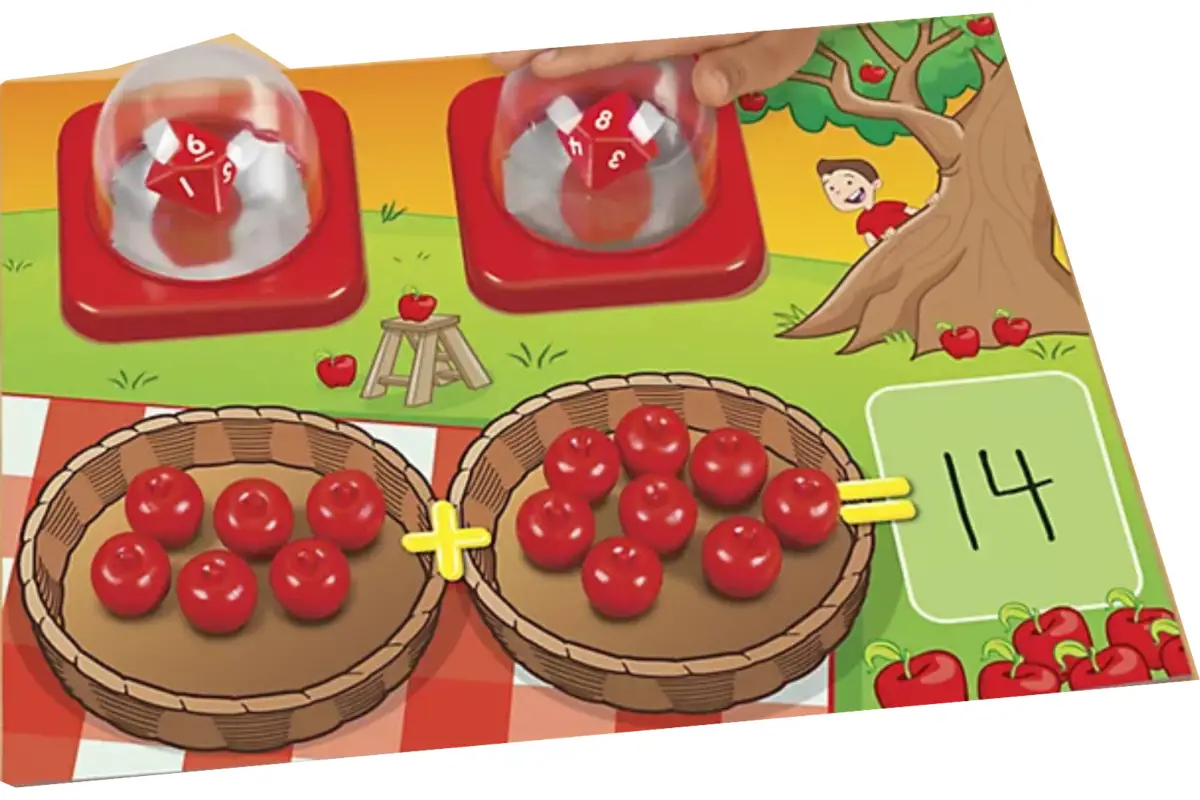
★★★★☆
For Teachers | Age 4-6 | 1-2 Players
Pop and Add to 20 Game teaches counting and adding numbers within 20.
teaches counting and adding numbers within 20.
In this game, children create addition problems using two dice poppers. Then, they match the rolled numbers with apple counters, add, and write the sum on the board.
The positive features:
- The game components are bright and colorful
- Can replace apples with other objects
- Great for teaching addition to tactile learning students
A few reminders:
- Young children may need help to press the dice poppers
- There are only 25 apples to use, so the practice is limited
- It does not come with erasable markers
I recommend playing Pop and Add to 20 Game with kindergarten children because it is engaging and easy to teach.
with kindergarten children because it is engaging and easy to teach.
Simple Addition Magnetic Activity Tin (Lakeshore Learning)
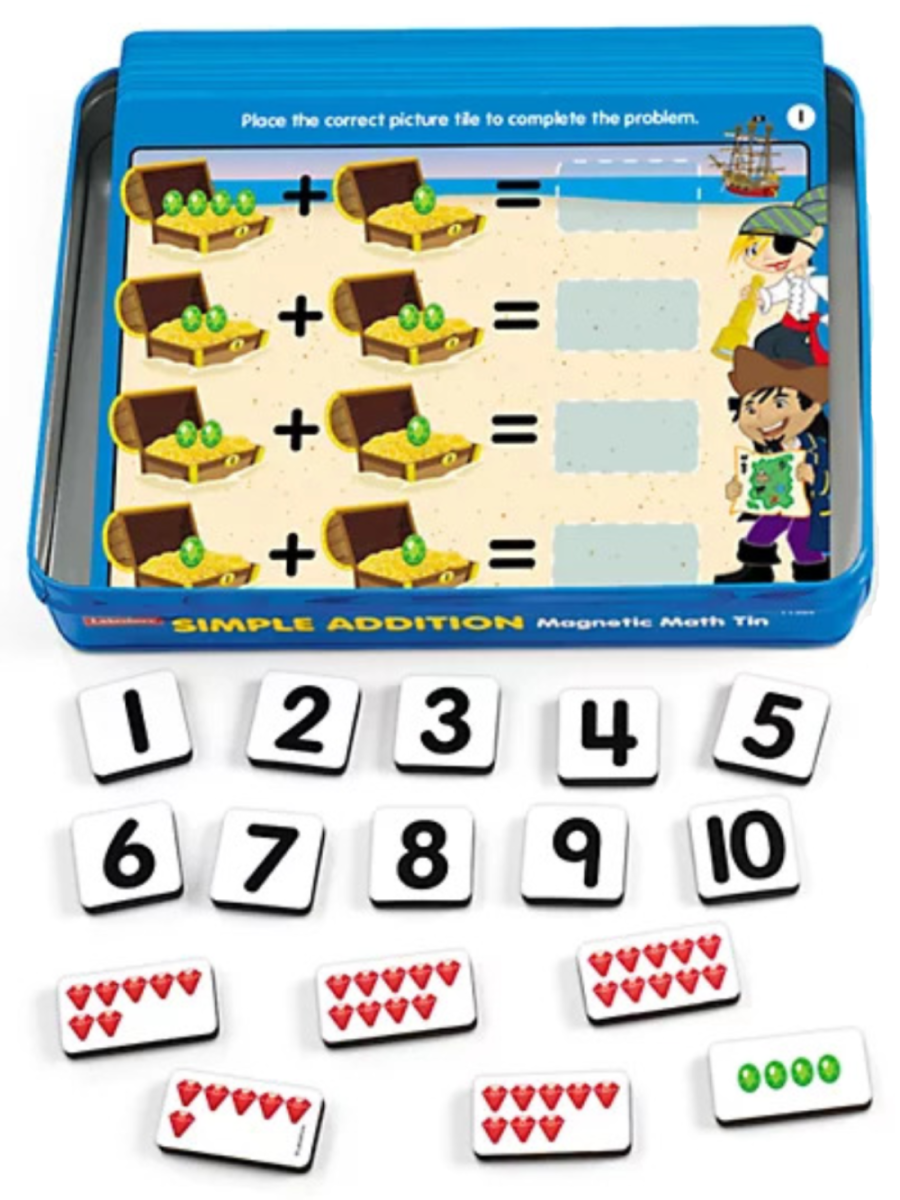
★★★☆☆
For Teachers| Age 4-6 | 1-3 Players
In Simple Addition Magnetic Activity Tin , children practice addition by manipulating 20 magnets on 15 colorfully illustrated activity mats. It has a durable storage tin that can be used on the activity board.
, children practice addition by manipulating 20 magnets on 15 colorfully illustrated activity mats. It has a durable storage tin that can be used on the activity board.
This board game can accommodate up to 3 players, but playing solo is more rewarding.
There are two ways to enjoy this set:
- Finding the missing addend to complete the equation
- Finding the sum to complete the equation
It does not cover all the addition facts but is good enough to introduce addition to children aged 4-6.
Addition Flip & Solve Board (Lakeshore Learning)
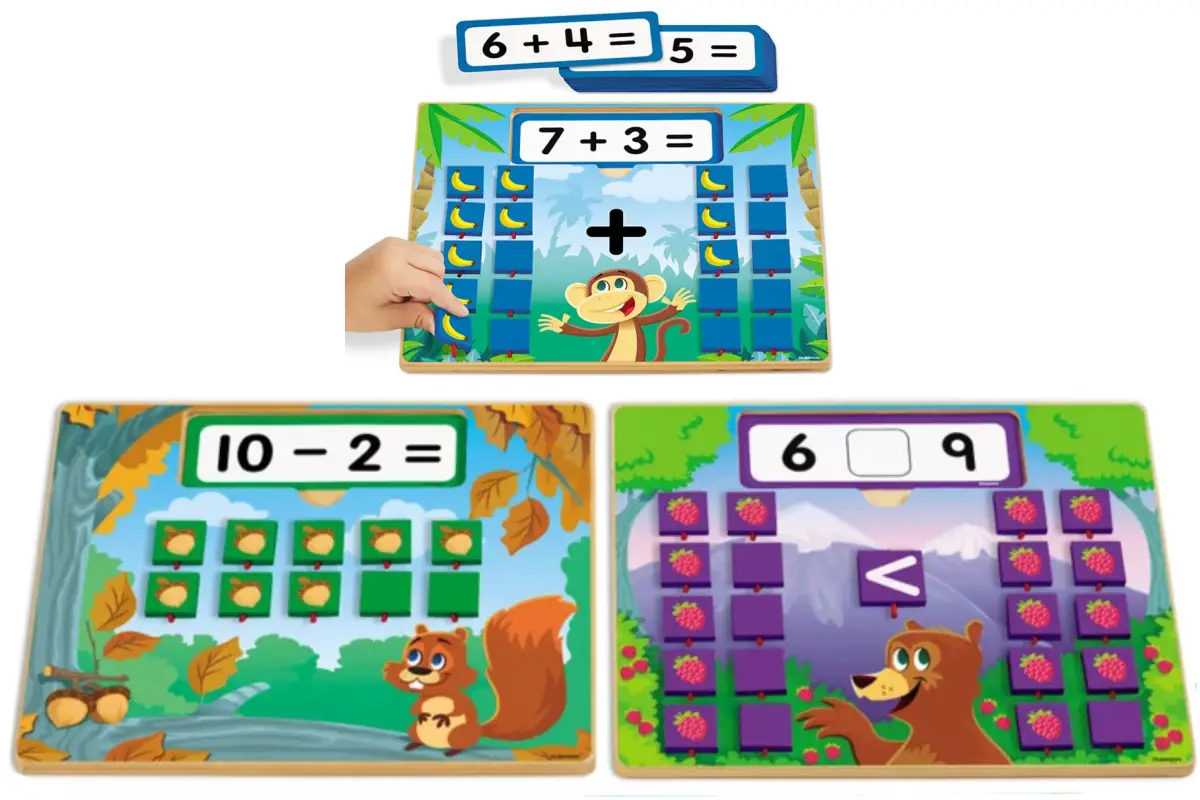
★★★☆☆
For Parents and Teachers | Age 3-6 | 1-2 Players
In Addition Flip & Solve Board , children can practice adding numbers within 20.
, children can practice adding numbers within 20.
To play:
- Pick an equation card.
- Flip the same number of banana tiles as the addends on the equation.
- Count the bananas, then answer the equation.
- Turn over the equation card to check the answer.
This game may accommodate up to 2 players but is perfect for solo play. Children can also play independently since the equation cards have the answers on their flip side.
You can improve this game by making cards with sums only so that children can practice decomposing numbers within 20.
9 Addition and Subtraction Board Games for Kindergarten to Grade 3
Sum Swamp (Learning Resources)
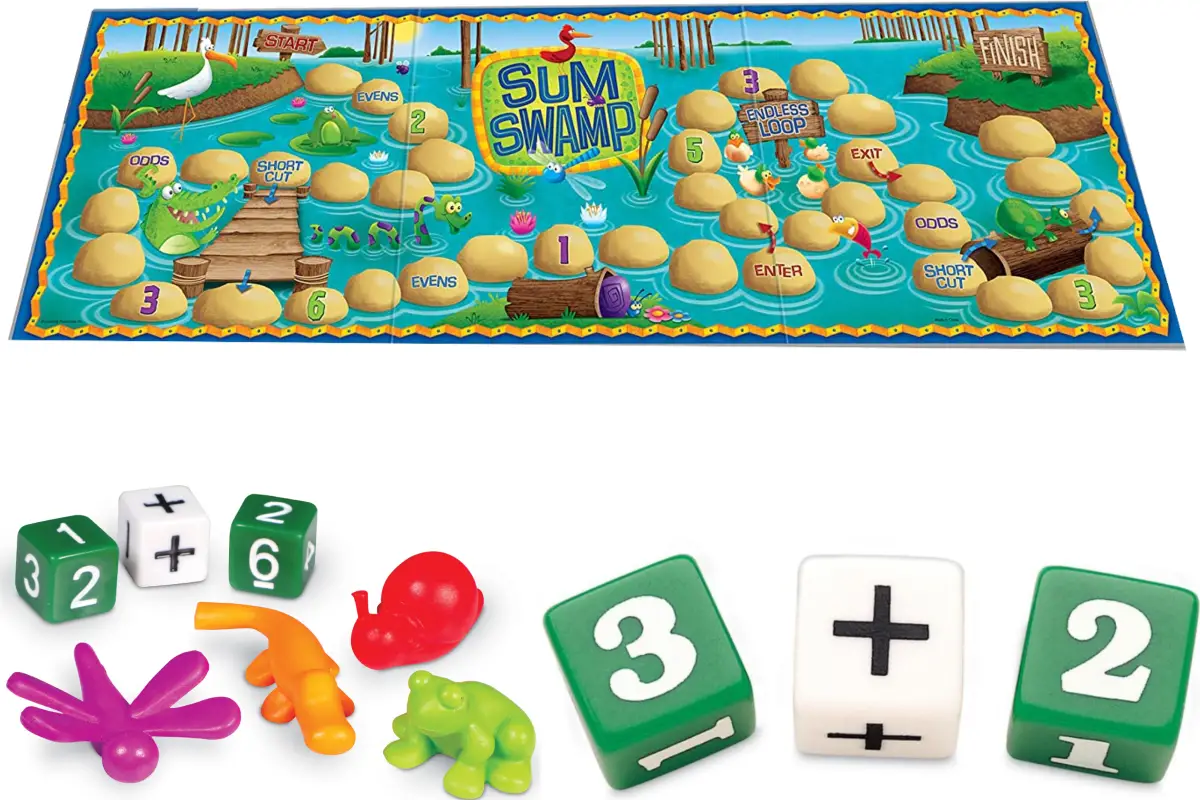
★★★★☆
For Parents and Teachers | Age 5+ | 2-4 Players
Players race through the swamp while they solve addition and subtraction problems in Sum Swamp .
.
In this game, players roll the number dice and operation die (plus or minus signs) to create an addition or subtraction problem. Then, they move their swamp creature based on the answer.
Things I like:
- The game includes interesting features like shortcuts and endless loops
- The board has beautiful artwork
- You can replace the number dice with 10-sided or 12-sided dice to teach addition and subtraction with larger numbers
- It teaches odd and even numbers
Pop to Win! Math Game- Gr. 2 (Lakeshore Learning)
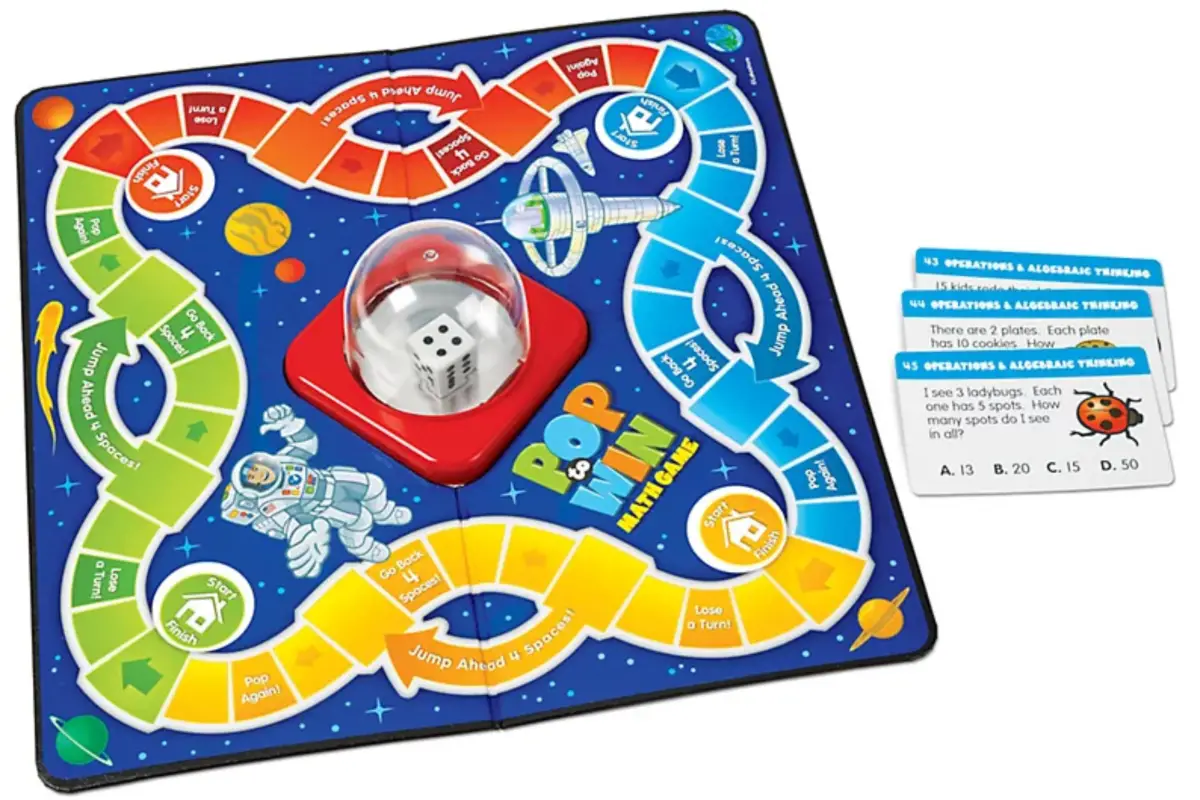
★★★★☆
For Parents and Teachers | Age: 7 | 2-4 Players
In Pop to Win! Math Game-Gr. 2 , players travel around the space-themed gameboard by answering 75 questions correctly. This game consists of a gameboard, four color-coded tokens, and 75 multiple-choice type word problem cards.
, players travel around the space-themed gameboard by answering 75 questions correctly. This game consists of a gameboard, four color-coded tokens, and 75 multiple-choice type word problem cards.
The questions teach skills like:
- Adding or subtracting numbers
- Counting money
- Telling time
The pros:
- Children can use the cards as quiz cards
- The cards are labeled and can be sorted according to difficulty and category
- It comes with an answer card for easy scoring and self-review
I recommend Pop to Win! Math Game-Gr. 2 because the game offers various grade-appropriate and challenging questions that help introduce math concepts.
because the game offers various grade-appropriate and challenging questions that help introduce math concepts.
Cloud Hoppers (Logic Roots)
★★★★☆
For Parents and Teachers | Age 6+ | 2-4 Players | Game Duration: 10-15 minutes
Cloud Hoppers is an alien-themed addition and subtraction board game.
is an alien-themed addition and subtraction board game.
Each player gets two game tokens, and they need to get both pieces to the Cyta flower (20 on the gameboard) to win. There are two primary rules:
- On the cloud zone, subtract the number on the dice from your current position.
- On the plant zone, add the number on the dice to your current position.
This game has stunning artwork and sturdy game pieces. It also features an interesting alien story in the rulebook.
However, Cloud Hoppers focuses more on subtraction than addition. It also starts with a double-digit number, which may be challenging for younger kids. So, while the game encourages them to do mental math, having your child use a pen and paper to do the equations may be necessary.
Mathemagical World (Mind Inventions)

★★★☆☆
For Parents and Teachers | Age: 5+| 2-4 Players | Game Duration: 30 minutes
Mathemagical World is a roll-and-move subtraction and addition board game featuring eight magical islands: Desert Island, Dinosaur Island, Pirate Island, Zombie Island, Unicorn Island, Ice Island, Dragon Island, and Ninja Island.
is a roll-and-move subtraction and addition board game featuring eight magical islands: Desert Island, Dinosaur Island, Pirate Island, Zombie Island, Unicorn Island, Ice Island, Dragon Island, and Ninja Island.
The game offers two levels of difficulty:
- Regular mode – recommended for beginners (K-Gr.1) for learning to add and subtract numbers within 12
- Speedy mode – suitable for first and second graders for practicing adding and subtracting numbers within 20
The good points:
- It can be used to introduce counting to kindergarteners
- It is easy to set up and fast-paced game
I recommend Mathemagical World because it also includes adding and subtracting double and half concepts like move forward half four which means move two space.
because it also includes adding and subtracting double and half concepts like move forward half four which means move two space.
Bus Stop (Orchard Toys)
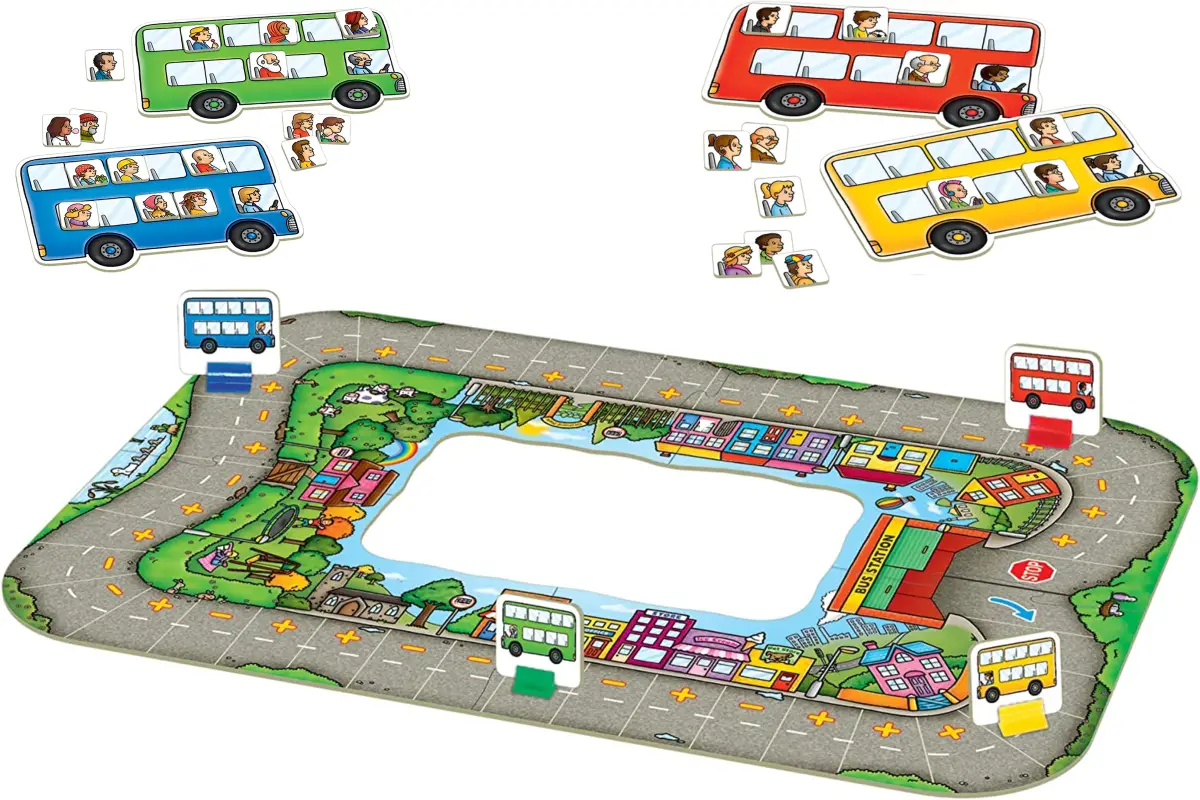
★★★☆☆
For Parents and Teachers | Age 4-7 | 2-4 Players
Children add and subtract passengers as they race through the gameboard to reach the Bus Stop . This board game contains 40 passenger cards and four bus boards.
. This board game contains 40 passenger cards and four bus boards.
Players roll the dice and move the bus in place. Then, flick the spinner to determine how many people to add or subtract from your bus.
The pros:
- Great for tactile learning students
- Teaches to add and subtract within ten
- Adding and subtracting passengers is a realistic and fun concept
The cons:
- Subtracting values less the people in the buses is confusing for children, like disembarking five passengers when they only have 3
- Low variability during play as players often have 0 passengers because there are more minus signs on the board
Race to Planet X (Little Phone LLC)

★★★☆☆
For Teachers | Age: 6-8 | 2-4 Players | Game Duration: 15 minutes
Race to Planet X is a space-themed racing board game where players create Power Combos, number bonds, to move forward. A Power Combo is three cards that make a number sentence like 7+1 =8.
is a space-themed racing board game where players create Power Combos, number bonds, to move forward. A Power Combo is three cards that make a number sentence like 7+1 =8.
There is a learning curve to teaching how to play this game. However, it is still an excellent game for first and second graders to practice adding and subtracting numbers within 20. They will also enjoy the game’s fun features:
- Stealing cards from opponents
- Using special cards to advance or move opponents backward
Hi Ho! Cherry-O (Hasbro)

★★★☆☆
For Teachers and Parents | Age: 5-7 | 2-4 Players
In Hi Ho! Cherry-O , players race to fill their baskets with ten fruit produce. Each player can choose from four color-coded fruit types:
, players race to fill their baskets with ten fruit produce. Each player can choose from four color-coded fruit types:
- green for apples
- blue for blueberry
- orange for oranges
- Red for cherries
This game does not teach addition and subtraction directly. But children indirectly learn these processes when trying to figure out how many fruits they still need to win. Adults can also reinforce these skills during play.
The good features:
- The game components are attractive and colorful
- It is easy to set up and play.
- It has a game variation for cooperative play
However, this game has low replayability, especially for children with strong math skills.
Tri-Fact-A (Learning Resources)
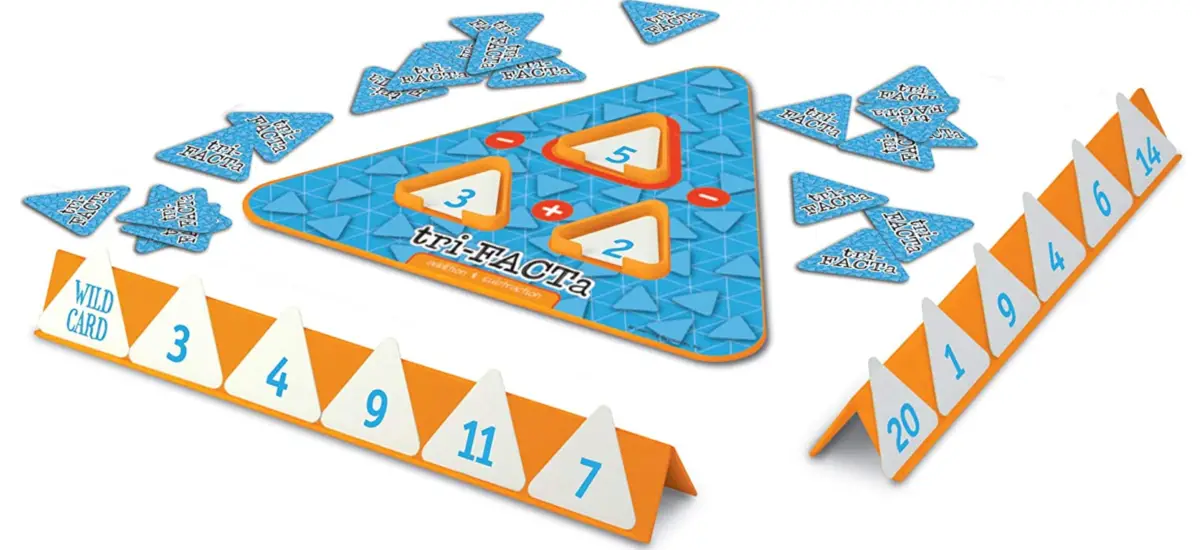
★★★☆☆
For Teachers| Age: 6-10 | 2-4 Players
Tri-Facta builds math fact fluency up to 20.
builds math fact fluency up to 20.
Each player gets a turn to create a true fact triangle – the top number has to be the sum or difference of the bottom two numbers. The first player to get rid of all their cards shouts “Tri-Facta” and wins the game.
I recommend this game because it is challenging. It also helps first and second graders understand the relationship between addition and subtraction. However, the cards are flimsy. And children who are struggling with addition and subtraction may also find this too challenging and may need more time to finish a turn.
Unicorn Sparkle Sums (Melby Toys)
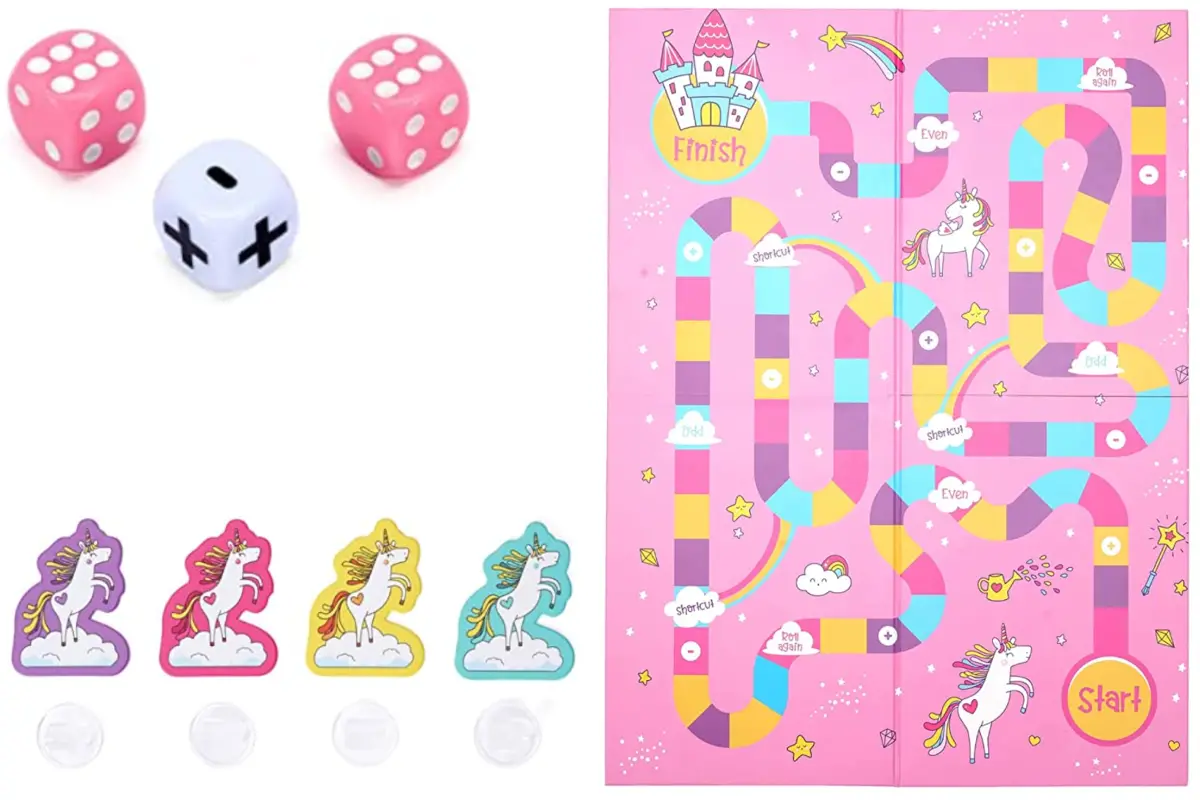
★★★☆☆
For Parents and Teachers | Age 4-8 | 1-4 Players
Unicorn Sparkle Sums is a roll-and-move board game where players must solve an addition or subtraction problem to move across the board.
is a roll-and-move board game where players must solve an addition or subtraction problem to move across the board.
This board game consists of a gameboard, four unicorn tokens, and three six-sided dice (2 regular pink dice and one white dice with the plus and minus signs).
To practice subtracting or adding two-digit numbers, you may add more dice or increase the allowed roll per turn.
This game deserves a three-star rating because:
- The unicorn-themed board is visually appealing to children.
- The game is easy to teach and play.
- It works for independent play but is most enjoyable with 2-4 players
Other Addition and Subtraction Games
For more addition and subtraction game suggestions, you might want to read my other posts:
- 15 Addition and Subtraction Card Games for PreK to 5th Graders

- 14 Addition Card Games for Families and School

- 11 Addition and Subtraction Puzzles for Preschoolers to Grade 2

Edudingo.com is a participant in the Amazon Services LLC Associates Program, an affiliate advertising program designed to provide a means for sites to earn advertising fees by advertising and linking to Amazon.com. We also participate in other affiliate programs which compensate us for referring traffic.
